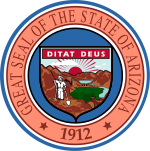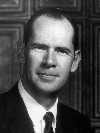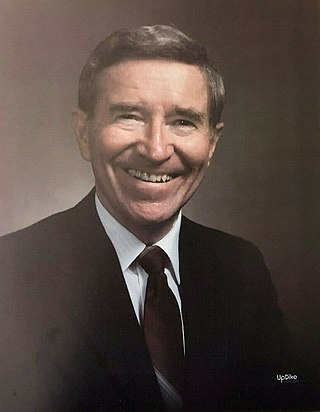
Evan Mecham was an American businessman and the 17th governor of Arizona, serving from January 5, 1987, until his impeachment conviction on April 4, 1988. A decorated veteran of World War II, Mecham was a successful automotive dealership owner and occasional newspaper publisher.

The 1970 United States Senate elections was an election for the United States Senate. It took place on November 3, with the 33 seats of Class 1 contested in regular elections. Special elections were also held to fill vacancies. These races occurred in the middle of Richard Nixon's first term as president. The Democrats lost a net of three seats, while the Republicans and the Conservative Party of New York picked up one net seat each, and former Democrat Harry F. Byrd Jr. was re-elected as an independent.

The 1968 United States Senate elections were elections for the United States Senate. Held on November 5, the 34 seats of Class 3 were contested in regular elections. They coincided with the presidential election of the same year. The Republicans picked up five net seats in the Senate. This saw Republicans win a Senate seat in Florida for the first time since Reconstruction.

The 1964 United States Senate elections were held on November 3. The 33 seats of Class 1 were contested in regular elections. Special elections were also held to fill vacancies. They coincided with the election of President Lyndon B. Johnson by an overwhelming majority, to a full term. His Democratic Party picked up a net two seats from the Republicans. As of 2023, this was the last time either party has had a two-thirds majority in the Senate, which allowed the Senate Democrats to override a veto, propose constitutional amendments, or convict and expel certain officials without any votes from Senate Republicans. However, internal divisions would have prevented the Democrats from having done so. The Senate election cycle coincided with Democratic gains in the House in the same year.

The 1962 United States Senate elections was an election for the United States Senate. Held on November 6, the 34 seats of Class 3 were contested in regular elections. Special elections were also held to fill vacancies. They occurred in the middle of President John F. Kennedy's term. His Democratic Party made a net gain of four seats from the Republicans, increasing their control of the Senate to 68–32. However, this was reduced to 67–33 between the election and the next Congress, as on November 18, 1962, Democrat Dennis Chávez, who was not up for election that year, died. He was replaced on November 30, 1962, by Republican appointee Edwin L. Mechem. Additionally, Democrat Strom Thurmond became a Republican in 1964, further reducing Democrats to 66–34. This was the first time since 1932 that Democrats gained seats in this class of Senators.
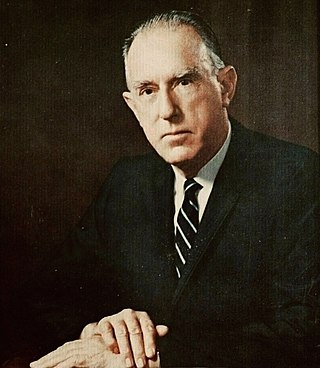
Paul Jones Fannin was an American businessman and politician. A Republican, he served as a U.S. Senator from Arizona from 1965 to 1977. He previously served as the 11th governor of Arizona from 1959 to 1965.

The 1986 United States Senate election in Arizona was held on November 4, 1986. Incumbent Republican U.S. Senator Barry Goldwater decided to retire instead of seeking a sixth term. The open seat was won by John McCain, a Republican congressman from Arizona's 1st congressional district and former Navy officer, as well as future 2008 presidential nominee against Democrat Barack Obama, as so was Goldwater in 1964 against incumbent Democrat Lyndon B. Johnson. McCain would remain in the Senate until his death on August 25, 2018.

The 1964 United States Senate election in Arizona took place on November 3, 1964. Incumbent Republican U.S. Senator Barry Goldwater decided not to run for reelection to a third term, instead running for President of the United States as the Republican Party nominee against Lyndon B. Johnson. Arizona Governor Paul Fannin ran unopposed in the Republican primary, and defeated Democratic nominee Roy Elson, who was a staff member for U.S. Senator Carl Hayden until Hayden's retirement in 1969, after which Goldwater held that seat from 1969 to 1987.
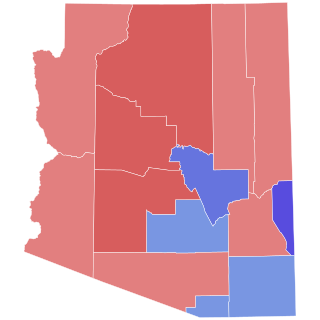
The 1968 United States Senate election in Arizona took place on November 5, 1968. Incumbent Democratic U.S. Senator Carl Hayden, 91, decided not run for reelection to an eighth term, ending his 57-year-long career in Congress. Hayden's longtime staff member Roy Elson ran as the Democratic Party nominee to replace him. Elson was defeated by a wide margin, however, by former U.S. Senator and 1964 Republican presidential nominee Barry Goldwater, who staged a political comeback. Prior to Goldwater's election, the seat had been held for decades by the Democratic Party under Carl Hayden, but after this election remained in Republican Party control continuously for 52 years, until Democrat Mark Kelly won in the 2020 special election.

The 1962 United States Senate election in Arizona took place on November 6, 1962. Incumbent Democratic U.S. Senator Carl Hayden ran for reelection to a seventh term, defeating Republican State Senator Evan Mecham in the general election. Mecham became Governor of Arizona more than two decades later, and was subsequently impeached and removed from office.

The 1980 United States Senate election in Arizona took place on November 4, 1980. Incumbent Republican Senator Barry Goldwater decided to run for reelection to a third consecutive term, after returning to the Senate in 1968 following his failed presidential run in 1964 against Lyndon B. Johnson. Despite Republican presidential nominee Ronald Reagan's landslide win in Arizona, Goldwater defeated Democratic Party nominee Bill Schulz in the general election by a narrow margin, which later caused Goldwater to decide against running for reelection to a fourth consecutive term. Goldwater won only three counties, including Maricopa County.

The 1994 Arizona gubernatorial election took place on November 8, 1994, for the post of Governor of Arizona. Fife Symington, the incumbent Republican Governor of Arizona, defeated the Democratic nominee Eddie Basha to win a second term in office. However, Symington resigned in 1997 due to a federal indictment on corruption charges.

The 1990–91 Arizona gubernatorial election took place on November 6, 1990, for the post of Governor of Arizona. Incumbent Democratic Governor, Rose Mofford, declined to run for a full term. Republican Fife Symington defeated the Democratic nominee and Mayor of Phoenix Terry Goddard. Because no candidate received a majority of votes, a runoff election was held later on February 26, 1991, which Symington also won. This is the only election where Arizona used a runoff election.

The 1986 Arizona gubernatorial election took place on November 4, 1986, for the post of Governor of Arizona. Republican Evan Mecham, who defeated Burton Barr for the Republican nomination, defeated the Democratic nominee and State Superintendent Carolyn Warner and independent candidate Bill Schulz.

The 1982 Arizona gubernatorial election took place on November 2, 1982, for the post of Governor of Arizona. Democratic incumbent Bruce Babbitt defeated Republican nominee Leo Corbet and Libertarian candidate and former U.S. Representative Sam Steiger. Evan Mecham unsuccessfully ran for the Republican nomination. This was the last time until 2002 that a Democrat was elected governor of Arizona, and the last time a male Democrat was elected governor.
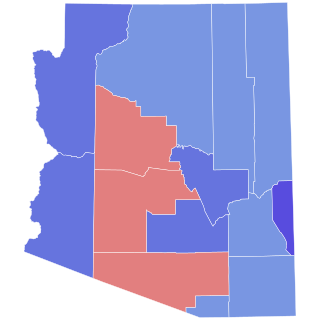
The 1954 Arizona gubernatorial election took place on November 2, 1954. Incumbent Governor John Howard Pyle, the first Republican elected to the office in two decades, ran for reelection for a third term.

The 1958 Arizona gubernatorial election took place on November 4, 1958. Incumbent Governor Ernest McFarland decided not to run for reelection and instead unsuccessfully challenged U.S. Senator Barry Goldwater in attempt to return to the United States Senate.

The 1962 Arizona gubernatorial election took place on November 6, 1962. Incumbent Governor Paul Fannin ran for reelection against President of the Western Conference of United Funds Samuel Pearson Goddard in the general election, winning a third consecutive term, a first for a Republican Governor in Arizona. Fannin was sworn into his third term on January 1, 1963.

The 1974 Arizona gubernatorial election took place on November 5, 1974. Incumbent Governor Jack Williams decided not to run for a fourth term as governor. Former United States Ambassador to Bolivia Raúl Héctor Castro, who was the Democratic nominee in 1970, won the Democratic nomination again in 1974, and narrowly won the general election, defeating Republican nominee Russell Williams by 0.85%. Castro was sworn into his first and only term as governor on January 6, 1975.
William R. Schulz is an American businessman who was an Independent candidate for Governor of Arizona in the 1986 gubernatorial election, and was the Democratic nominee against Barry Goldwater in the 1980 U.S. Senate election.

